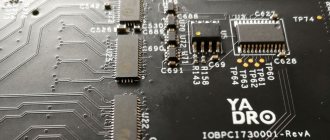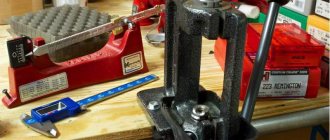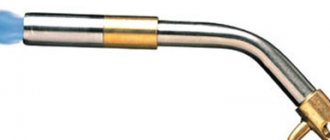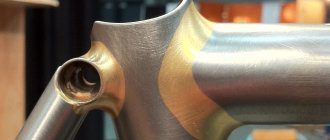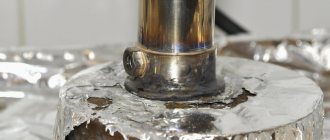- home
- Construction and renovation
- Plumbing
>
>
⬎
There is nothing complicated in the process of welding PPR pipes, which is why this technology has become widespread. Any home craftsman can perform a minimum set of equipment and tools, as well as a little knowledge and plumbing soldering.
However, many beginners and even “masters” often violate the technology of connecting polypropylene pipes, although by and large there is no room for error. Therefore, I suggest that you familiarize yourself with basic information and simple tips.
Necessary tools and materials for soldering
To work at home, you will need to prepare in advance all the necessary tools and materials:
- electric soldering iron;
- nozzles and stands for a soldering iron of the appropriate size;
- a file or sharp knife for removing burrs;
- measuring ruler or tape measure;
- marker;
- pipe cutting scissors;
- shaver - a device for removing the reinforcing layer;
- special tool for chamfering;
- solder for soldering;
- fluxes and fittings;
- alcohol composition for degreasing.
Solder for soldering
Solder comes in the form of wire, foil, rod, etc. It is necessary to obtain a stronger weld on copper structures. It is made on the basis of tin, silver, zinc, lead, antimony or copper.
Depending on the melting point it is divided into:
- fusible;
- medium fusible;
- high fusible solder.
Fluxes and fittings
Fluxes are used in soldering to protect the metal surfaces being joined from oxidation. They are available in the form of a liquid, a dry mixture or a paste and differ in chemical composition, properties and purpose. For example, boric acid, zinc chloride, and hydrochloric acid are used to clean the surface of rolled copper and increase the fluidity of solder.
A protective film can be created using rosin, wax, and various resins.
Fittings are small-sized products that are placed on the ends of pipes that are connected by soldering. These include couplings, tees, crosses, contours, plugs, corners, etc. They must be made of the same material as the pipes themselves. And of course, it’s no secret that you can buy fittings at any plumbing store.
Cutting scissors
This type of tool has other names - pipe cutter, pipe shears or pipe cutter. It is designed for fast cutting of plastic products, providing a burr-free cutting edge, which simplifies preparation for the welding process.
There are 4 types of pipe shears, differing in design and price:
- precision pipe cutter with a ratchet mechanism. The device is used for cutting pipes with a diameter of no more than 75 mm;
- roller shears;
- automatic pipe cutter in the shape of a pistol;
- pipe cutter - guillotine.
PPR connection without welding
The technology for connecting PPR without a soldering iron is called “cold” welding. This method is based on the use of a strong organic solvent. The surface of the pipe treated with this composition becomes sticky, soft and easily joins with another part. The solvent is highly volatile and evaporates in a few seconds, so the process of gluing parts takes place in a short period.
To connect PPR without welding, soldering machines and electricity are not needed. Therefore, this method has become widespread among professional installers and is used when laying or repairing trunk lines. In everyday life, this method is extremely rare.
Tips for choosing and using a pipe soldering iron
When choosing a pipe soldering iron, you should take into account its technical parameters:
- power. Powerful devices are needed for welding large-diameter pipes; for domestic systems, in which the diameter of the products does not exceed 50 mm, you can purchase a device with a power of 0.6 - 0.8 kW;
- quality of coating of nozzles and technology of their use. The products to be welded can be easily removed from Teflon-coated nozzles, so it is advisable to choose a soldering iron equipped with just such nozzles. In addition, you should pay attention to the possibility of heating not only one, but two or three nozzles at the same time. This will significantly speed up the work;
- type of temperature controller. The soldering iron can be equipped with an electronic, capillary or bimetallic thermostat. It is better to choose a model with an electronic temperature controller, since the other two have too large a discrepancy between the set and actual heating temperature of the products.
Kinds
Metal-plastic Polyethylene
Such communications are divided into subtypes:
- Polyethylene - used for laying wiring inside buildings and external routes. They can be used on high-pressure pipe connections and at low ambient temperatures.
- PVC is used to reduce the cost of repairs.
- Metal-plastic ones are the most practical products, with a useful life of more than 50 years. Ideal option for replacing hot water supply.
The widespread use of this material is due to a number of reasons. Positive properties of such structures, in contrast to metal ones:
- Long service life.
- Low corrosivity.
- Easy to install.
- Does not require special skills.
- Environmentally friendly material.
- Economical and easy to use.
- Lightweight and easy to transport.
- Resistant to the harmful effects of microorganisms.
The essence of the process and soldering methods
Soldering is used for hermetically connecting pipeline sections to each other, installing shut-off valves, control, measuring and safety devices.
Three soldering technologies are used to connect the ends of pipes and pipe fittings:
- diffusion method. Welding is carried out by heating and squeezing the connecting elements without melting the base material of the parts and the use of additional substances;
- soldering using electrical fittings. For connection, special fittings with a heating element are used. The soldering process occurs due to partial melting of the internal part of the electrical fitting under the influence of electric current;
- cold way. The elements of the heat pipe are connected using additional material - solder.
How to connect a metal-plastic pipe with a polypropylene pipe
Due to various circumstances, it happens that it is necessary to connect different types of pipes, for example, PPR and steel, metal-plastic with polypropylene, and so on. Such situations happen in apartments where it is difficult to change a section of a common water supply or heating riser laid with a steel or metal-plastic pipe, but you need to connect to it. This is not a big problem, you just need to take into account that all such connections are made through threaded fittings.
Since metal-plastic pipes can be connected using press and dismountable fittings, for joining with polypropylene it is more convenient to use a detachable fitting with an external thread. In turn, a fitting with an external thread is soldered to the end of the polypropylene pipe, after which the connection is twisted in the traditional way, with flax or fum tape wound up.
Detachable fitting for connecting pipes
When you need to cut into metal-plastic pipes, it is most convenient to install a tee with a threaded outlet, where you can subsequently screw the fitting, and then solder the polypropylene pipe to it. True, you will have to tinker with the installation of the tee: you need to turn off the water or empty the heating system, and then cut the metal-plastic and carry out the installation.
Step-by-step instructions for soldering plastic pipes
Pipeline soldering consists of three main phases - heating, joining, fixing and cooling of elements, the implementation of which requires certain preparation, compliance with temperature conditions and safety rules.
Security measures
During the soldering process, you need to follow basic safety precautions for working with power tools:
- the soldering iron must be protected from precipitation, dirt and splashes;
- Before connecting the device to the network, you must make sure that it is in working order and that the power cord and plug are intact;
- During work, you should ventilate the room and use thermal gloves;
- Do not touch exposed skin to heated surfaces.
Preparation of elements and parts
At this stage you need to do:
- cutting products into pieces of the required length;
- cleaning the cuts from burrs and thoroughly polishing them;
- degreasing the sections with an alcohol solution;
- drawing a notch by which it will be possible to control the depth of insertion of pipes into the apparatus;
Preparing the soldering iron
The device must be connected to the network in advance, the thermostat must be set to the desired position and the product must be heated to operating temperatures, depending on the type of plastic.
Typically, the heating time of the soldering iron is 30 minutes until the light goes out. The device will be ready for operation 10 minutes after reaching the set temperature.
When preparing the apparatus, it is also advisable to additionally control the temperature of the fittings and sleeves with a surface electric thermometer.
At what temperature should plastic pipes be soldered?
For soldering polyethylene products, the temperature regulator on the device is set to 220ºС, for polypropylene products - to 260ºС. If there is no regulator, you can adhere to the heating parameters of the parts from Table 1.
Table 1.
| Parameter name | Pipe diameter, mm | |||||
| 20 | 25 | 32 | 40 | 50 | 63 | |
| Product heating time, sec | 6 | 7 | 8 | 12 | 18 | 24 |
| Product heating time, sec | 4 | 4 | 6 | 6 | 6 | 8 |
| Cooling time, min | 2 | 2 | 4 | 4 | 4 | 6 |
Docking rules
When assembling joints, it is necessary to ensure that the edges are aligned so that the surfaces of both products coincide and the axis of the pipeline does not shift. The gap between the edges should be uniform over the entire diameter with a size of 2 - 3 mm.
Pipe connection
The heated parts are removed from the soldering iron nozzles and connected to each other, lightly pressing with their ends. The polymer will harden in 2-3 minutes.
Cleaning and cooling connections
The connection point should be in a stationary position until the plastic cools to a temperature of 38 - 42 degrees. To do this, the connected parts are fixed in a clamp or clip until cooling.
Cleaning of the deposits is carried out with a sharp knife after the joint area has completely cooled.
Checking the connection quality
At the end of welding, all joints are subject to visual inspection. A high-quality weld should have a smooth surface, without traces of porosity, cracks, folds and excessive shine that occur when overheated. The bead in the weld area must be continuous and uniform along the entire circumference of the joint and rise above the outer surface by no more than 2 mm - for products with a wall thickness of up to 10 mm.
The maximum bead height for pipes with larger wall thicknesses is 4 mm.
Equipment preparation
Not all models include a stand. The soldering iron is installed on a level surface in an easily accessible place so that it does not tip over due to carelessness. Nozzles of the required diameter are placed nearby. Some types of irons allow you to simultaneously use replaceable components of different diameters.
Iron components Source teplo-online.com
See also: Catalog of companies that specialize in water supply and sewerage.
The heating element is heated evenly along its entire length to a predetermined temperature. The degree of heating is pre-set on the panel. For polypropylene, the soldering temperature of polypropylene pipes on the scale is set at 260⁰. Warming up the device lasts 10-15 minutes. A cold room takes longer to warm up than a heated room. At temperatures below 0⁰, welding is prohibited.
Common mistakes
Soldering plastic pipes does not require special skills, but if you do not adhere to established norms and rules, you can still ruin the connection. Typical mistakes of novice masters are:
- using dirty attachments. If drops of molten polymer remain on the nozzles, then during the next welding they can wedge between the edges of the products and sharply weaken the connecting seam;
- residual water and dirt on the outer surface. They will prevent close contact of the surfaces of parts over the entire area;
- applying excessive force when combining parts. Part of the melt under excess pressure can be squeezed into the pipe and reduce its permeability;
- an attempt to clean up the sagging of molten plastic before the joint has completely cooled, which inevitably leads to deformation of the pipe;
- insufficient heating or overheating of the joint.
The nuances of maintaining the desired thermal regime
When designing a piping system, you should strive to ensure that the joints of pipes, fittings and fittings are in accessible places. The overall dimensions of the joint locations should make it possible to install a welding machine and place their ends onto the heater sleeves without significant bending of the pipes.
The closer to the joint the welding equipment can be placed, the less time the heated edge will have time to cool before welding. Such cooling during transportation leads to a significant decrease in the strength and durability of the joint.
It is also necessary to consider the sequence of installation of joints. It is not uncommon for inexperienced designers to find it impossible to install the last joint because the soldering iron simply does not fit into the remaining gap. You have to either strongly bend the pipes, creating residual stresses in them, or cut them and add another joint. Both solutions reduce the overall reliability and longevity of the system.
Experienced shareholders formulated the following recommendations:
- welding equipment must have a high-quality thermostat that ensures accurate setting and stability of maintaining the heating temperature;
- the distance from the welding point to the apparatus should be no more than 1 meter;
- welding should be carried out at room temperature;
- Before connecting, you need to check the temperature equality of both parts.
Following these simple rules will help you solder pipes efficiently.
Expert advice
To ensure maximum reliability of pipeline connections, experts advise adhering to the following requirements:
- it is correct to start welding work 10 minutes from the moment the soldering iron warms up;
- perform welding or soldering operations only at above-zero ambient temperatures;
- sections of pipes connected by welding must be allowed to cool, preventing them from moving relative to each other or twisting;
- For wall thicknesses greater than 6 mm, butt welding of products is performed using a double seam. With a smaller wall thickness, the joint can be sealed with one seam;
- all structural elements fixed by soldering must be from the same manufacturer, since they may differ in the composition of the ingredients in the raw materials, which will negatively affect the quality of the weld.
Soldering in hard-to-reach places and corners
When soldering pipes located in hard-to-reach places, for example, close to the surface of walls or ceilings, a special technique is used, which consists of sequential heating of the direct and counter sections of the connection with a soldering apparatus. It is necessary to warm up the flange of the straight section for a longer period of time so that it does not have time to cool down while the counter part of the workpiece is in operation.
A smooth line at corner joints of pipes can be achieved by using special corner adapters and fittings. In this case, it is important to very accurately mark in advance on the supply pipes the depth of their entry into the body of the corner piece.
Connecting plastic pipes without soldering
Plastic pipes do not have to be welded; they can be joined using a special adhesive. It is applied to the entire pre-degreased surface of the pipe section that will be inserted into the socket. In the bell, the inner surface is also degreased and covered with glue, but only 2/3. For better adhesion, the surfaces of the pipes under the adhesive joint are treated with sandpaper before degreasing.
The prepared part of the pipe is inserted into the socket until it stops and rotated 90 degrees. In this position, the parts to be glued should be held for 1 - 1.5 minutes until the glue sets.
The adhesive will dry completely within a few hours.
Plastic sewer pipes leading to the Tank septic tank can be connected using a compression fitting. With this method, the process of connecting pipes consists of the following steps:
- cleaning the top layer of the pipe from contaminants;
- chamfering at the end;
- loosening the union nut on the fitting and installing the end of the pipe into it;
- tightening the nut in the reverse position, at this moment the pipe is clamped (compressed) by the ferrule ring.
Fittings are fixed manually or using an open-end wrench. The applied force should not be excessive, otherwise the pipes may burst.
The socket method involves the use of a highly elastic sealing ring. The tightness of the connection is ensured by compression of the gasket between the walls of the socket and the smooth end of the pipe.
Welding large diameter plastic pipes
To connect pipes with a diameter of more than 50 mm and a wall thickness of 4 mm, butt soldering technology is used, which consists of simultaneous welding of the ends of 2 segments along the entire plane. The most difficult thing in this welding method is to correctly align the joints and ensure the required length of the gap between the parts.
Therefore, in the process of butt welding of large diameter pipes, guides or a pipe centralizer are used. It will provide high-quality and reliable fixation of sections for welding.
The work itself is carried out in the following order:
- pipe preparation and edge cleaning;
- securing elements in a pipe centralizer;
- welding of joints of products.
Property of polypropylene
Polypropylene is a product of the polymerization of 2 gases - ethylene and propylene. They are mixed in a certain ratio. As a result, it is possible to obtain granules from which pipes are made. This is done using the extrusion method.
The characteristics of the material are given in the table:
| Index | Meaning |
| Operating temperature range | -10 — +90 degrees |
| Melting point of plastic | 149 degrees |
| Nominal pressure | 1.5-2.5 atmospheres |
The specified characteristics are suitable for cold water supply. Thanks to fiberglass or aluminum reinforcement, it is possible to obtain products that are suitable for batteries and hot water supply.
What to pay attention to when planning pipe installation in an apartment or house
The process of welding polypropylene pipe
Independent welding of pipe elements for plumbing and heating will be successful if you take the following steps in advance:
- select pipeline materials and methods of connecting them
- select equipment for welding PP pipes
- identify difficult areas and decide whether independent installation of pipes in these areas is possible
If in doubt, you can consult with specialists. If you decide to carry out the installation yourself, you should pay attention to the selection of equipment and training.


